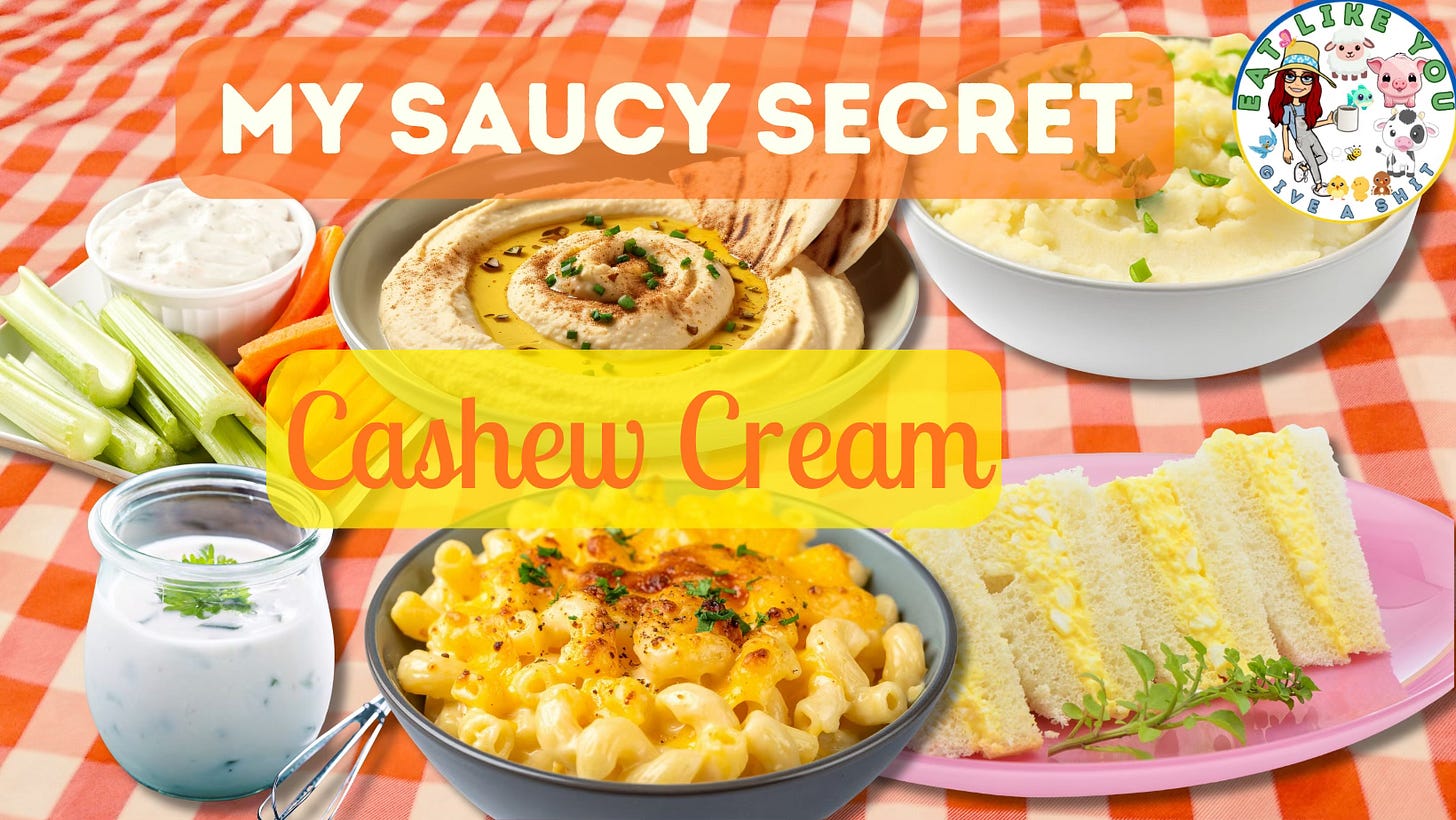So I’ve discovered the glories of cashew cream. It’s as simple as this:
Cashew Cream
2 cups cashews
Enough water to cover them
After a quick rinse, just cover the cashews in clear water, put them in a covered container, and stick them in the fridge overnight.
The next day, pour them into the smoothie cup of your high speed blender. Do not season them at this point.
Blend until smooth. Scrape into a container with a cover and refrigerate. Keeps for up to a week.
How to use it
Frosting
1 cup cashew cream
4 or 5 medjool dates, pitted & chopped
1 teaspoon vanilla
1 to 3 tablespoons soy milk
Add the cream, dates, vanilla, and blend on smoothie setting
TASTE
If it’s not sweet enough, add another date.
It it’s too thick, add another tablespoon milk.
Blend again on the smoothie setting.
Frosting Variations
Chocolate frosting: Add 2 tablespoons unsweetened baking cocoa and one more date. This will thicken the frosting, so you might need another tablespoon of milk.
Mint chocolate frosting: Make the chocolate frosting. Add peppermint extract one drop at a time, blending after each addition and TASTING. And when I say one drop at a time I mean one drop at a time. It’s easy to go too far with mint.
Lemon or orange frosting: Make the vanilla frosting, but use a tablespoon of water instead of the milk. Then add lemon juice or orange juice just half teaspoon at a time, blending and TASTING after each addition. (Garnish with zest for a fancy touch and a blast of flavor!)
Strawberry frosting: Make the vanilla frosting recipe and add strawberry extract a drop at a time, blending and TASTING after each addition.
*I put TASTING in all caps because so many new cooks skip it, and just follow the recipe like it’s a religious rite. Recipes are part what’s written down, and partly what the cook does with it. So taste, dammit. Taste like the wind!
Use in Salads
Potato salad, macaroni salad, chickpea egg or chickpea tuna salad—all of them need something creamy to perfect their texture.
You can season the salad and just add a scoop for texture. Or….
Cashew Salad Dressings
About 1/2 cup cashew cream
2 tablespoons dill pickle relish
1 stalk celery, finely chopped
2 teaspoons yellow mustard
1/2 teaspoon onion powder
1/2 teaspoon garlic powder
1/4 teaspoon turmeric
Several strong grinds or shakes of black pepper
Two good pinches of kala namak black salt for an eggy flavor (Optional)
So I use a spoonful of this in the chickpea salad sandwich mix hubs has fallen for. I spread it thick on toasted Dave’s Killer Bread, with a whole honkin’ handful of raw greens. I slice up a tomato but pack it in a separate container so he can apply it to the sandwich when he’s ready to eat it, avoiding soggy bread.
I also add a scoop to my macaroni and or potato salads instead of mayo.
Thinning this out a bit more, maybe shifting some of the herbs, you can make a decent ranch dressing.
Cheesy applications
The cheese sauce recipe, I’ve given elsewhere, and it’s the best I’ve had. But you can simplify here by adding some jarred roasted red pepper (oil-free) and some nutritional yeast. Start with two tablespoons nooch to 1/2 cup of cashew cream, blend, and then…you know I’m going to say taste it, right?
You can use it for Mac & cheese, or potatoes au gratin, or as even a layer in your veggie lasagna. It works for any other dish that calls for cheese sauce.
Thickened up (less liquid, more nooch) you can make a cheese dip for veggies.
French Onion Dip
Make the base recipe, then add caramelized onion, finely chopped chives, fresh parsley, and maybe a splash of low sodium tamari. (You can cook your onions oil-free and there’s a demo HERE. To caramelize, just cook them longer. You need to get that sugar starting to stick to the pan, then add a splash of water to reconstitute it.)
I think you’re beginning to see the applications here!
Summing up
So love making the basic cashew cream recipe on the weekend, then using it for various recipes throughout the week.
Caution: If you’re working to reverse heart disease you should limit nuts to two tablespoons per day. Easier to measure when they’re creamy, yes?
On the other hand, if you are exercising well, you can burn rather than store that fat content.
Remember, the plaque in the arteries comes from excess fats in the bloodstream. Animal and milk fats are the worst, non-animal saturated fats are next, of course. But any fat we don’t use can wind up there.
Excess calories are also stored as fat, and it’s fat that clogs our arteries. Clogged arteries is another term for “coronary artery disease” or “heart disease” for short.
A personal note: I’ve gotta tell you all how much I appreciate your subscriptions, and how much your presence here helps get me up in the morning.
Just the other day I was contemplating whether one of my blogs I might have to go. It’s a lot to keep up three (This, The Bliss Blog and the Coffee House Blog at MaggieShayne.com) while still writing a couple of novels a year and, you know, having a life.
But every time I consider it, somebody leaves a comment, or shares a post, or I get a new free subscriber, or a new paying subscriber which is like a shot of magical motivation juice, and I realize people are getting something important here. Some of you are even getting their health back. Some of you are going to life a few years longer, and a whole lot healthier than you would have, had you never stumbled upon this place. Thinking about that makes me tear-up!
So thank you from my heart for being here, free or paid.
And you paid subscribers, thank you times a million. I couldn’t keep this going without you.
Your Homework: If you’re new here, you might have missed my posts about how important to educate yourself on the whole food plant-based lifestyle from multiple sources. Here are a few of my go-to powerhouses of knowledge.
Documentaries
Forks Over Knives
What the Health
Cowspiracy
Seaspiracy
The Twins Project
Websites
Forksoverknives.com *Caution—they’re using oil in some recipes now. New ownership. But there are still thousands of recipes on the site that are truly WFPB and they have a free recipe app I use a lot.
NutritionFacts.org—Dr. Michael Greger’s site on nutrition with frequent videos on specific topics.
Nutritionstudies.org—Home of the T. Colin Campbell, Ph.D’s certificate course on plant based nutrition. When I took it, it was offered through Cornell University. Also jam packed with articles, recipes, and more.
PCRM.org—Home of the Physicians Committee for Responsible Medicine, another site packed with the latest peer reviewed research on nutrition and health, frequent videos on various nutritional topics, and lots more.
Podcasts
The Plantstrong Podcast by Rip Esselstyn, son of one of the founders of the WFPB movement, Dr. Caldwell B. Esselstyn Jr, who is keeping it going with a whole line of foods and this fantastic weekly podcast. Jon Stewart was a guest for a double episode!
Plant-Based by Ann & Jane Esselstyn This is Dr. Esselstyn’s wife Ann, who just turned 90, and their daughter (Rip’s sister) Ann. They cook a recipe a week and all of them are 100% WFPB.
The Physicians Committee Podcast: This is usually Dr. Neal Barnard of the Physicians Committee with guests discussing plant-based nutrition, and how it overcomes specific health. challenges.
That’s it for today, everyone. Thanks for being here. Be sure to like and subscribe, as it helps lift the blog in the algorithm. Sharing helps too!
Becoming a paid subscriber means you’ll get some glittery karma for all the years of healthy life we’re helping folks gain! (And when the cook book is done, you’ll get that free, too.)
Next time we’ll start talking Thanksgiving.
Don’t you just love it when, somehow, against all odds, and often on Christmas Eve, something wonderful happens? You know how it feels when you get to that point in the story. The way your throat clutches up a little, and your eyes burn.
I have enough Christmas romances to make you feel that a dozen times between now and the big night. They’ll put you in the spirit even better than binging Hallmark movies! And leave you feeling lifted right up.



